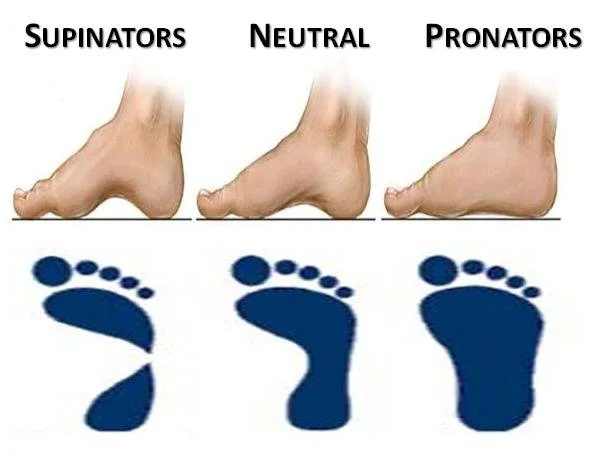Assessing your static and dynamic foot type can be difficult, but it seems simple when compared to the complexity and confusion associated with selecting the right shoes for your feet.This post will be focused on shoe selection and how to use information from the parts 1 & 2 to help you choose the right shoes.
Shoe Selection
Basic selection starts with finding which “group” your feet belong to. Using the previous 2 posts you can attempt to classify your foot type as either a supinator, neutral, or pronator. Within each category there is a continuum from minimal, moderate, to severe. Each different foot type is going to have a corresponding shoe type.
Shoe Characteristics
Shoe companies have come a long way since the one-size-fits-all flat soled shoe. While Converse still has a place in punk-rock bands and hipsters, it is fairly conclusive that these type of flats are not the best for athletic activities. Today there is a plethora of shoes available to accommodate just about every possible foot types. Walking into a shoe store can be confusing with all the different companies and characteristics. But to attempt to keep it simple, just look at 2 characteristics: pronation control and features.
Pronation Control
This is the most important characteristic to consider when choosing footwear. You want enough support to prevent any ankle instability or over-pronation, but not too much support to where it limits your normal foot motion. The midsole of the shoe is usually the predictor of how much support/control the shoe provides.Pronation control ranges from minimal (neutral foot types) to maximal (severe pronators) support
- Neutral shoes are for neutral foot types that have no over-pronating tendencies
- Support shoes helps maintain a neutral position of the foot during dynamic activities and prevent mild-mod over-pronating
- Motion control shoes will have a more aggressive support against severe over-pronating or severe ankle instability
Features
This is where the shoe companies often times try to separate themselves with the "latest technologies and innovations". Regardless of what the shoe companies are selling, the function of the features is always the same. It comes down to how much and what type of cushioning system the shoe has. The trade off here is that the more cushioning a shoe has, the heavier it is. Therefore, it is important to find the right amount of cushioning for your comfort and support, but not too much to where you care carrying unnecessary weight.Like pronation control, features can be considered on a continuum from minimal to maximal cushioning/features
- Minimal feature/cushioned shoes will usually be lighter and are best for athletes who don't need shock support and are not big heel strikers
- Maximal feature/cushioned shoes will usually be heavier and are best for athletes who require a great deal of shock support, have a strong heel strike and/or are over-supinators
Foot Type and Possible Shoe Type
This table will hopefully provide an idea of what shoe type might be best for you. Each individual has a unique foot type and therefore simply categorizing yourself into a 1 of 3 category is not always the answer. It all comes down to the proper fit, support, and comfort. Hopefully this table will give you a place to begin your search.
Considerations
Shoes are Made for Specific Athletic Activities
◊ Running shoes give anterior-posterior (sagittal) support
◊ Cross-Training shoes give more medial-lateral (coronal) support
◊ Always consider which event you are performing as you will need a shoe that can meet the specific demands of that activity
Where to Buy
◊ There are many specialty running stores and shoe stores that have a knowledgeable staff that can help you (please don't waste your time and money by going to the mall or a corporate chain store)
◊ If you have any injuries or pain it is best to be evaluated and fitted by a trained professional
◊ It helps to bring in your old shoes so that they can be assessed for the wear and tear
Wear Them in First
Wear your shoes in slowly. Try wearing them around some before going for a long run in a brand new shoe. This can possibly prevent some pain with the change in footwear.
When to buy new shoes?
General acceptable range is between 300-500 miles
Summary
Hopefully this 3 post series provides some information and understanding to the confusing world of footwear. As mentioned above, there are many factors to consider when choosing which shoes are right for you. Even if these posts do not lead you to the perfect shoe, I hope that it will at least prevent you from running in the wrong shoe.Part 1 - Static Foot AssessmentPart 2 - Dynamic Foot Assessment
Dig Deeper
www.runnersworld.comwww.runnerswarehouse.comhttp://www.wilkpt.com/Articles/Singles/buyingtherightshoe.htmlhttp://chrisjohnsonpt.com/defective-running-shoes-as-a-contributing-factor-in-running-injuries/
Update 2015
While this blog post series may provide some helpful knowledge, it should be known that static foot posture and selecting shoes based off of this foot type is not the best option. For more information please read this article on pathomechanics and refer to the GaitGuys for the most up to date information on shoes, feet, and gait.




